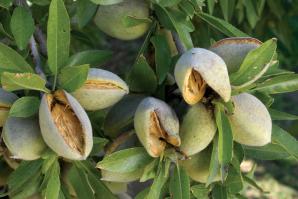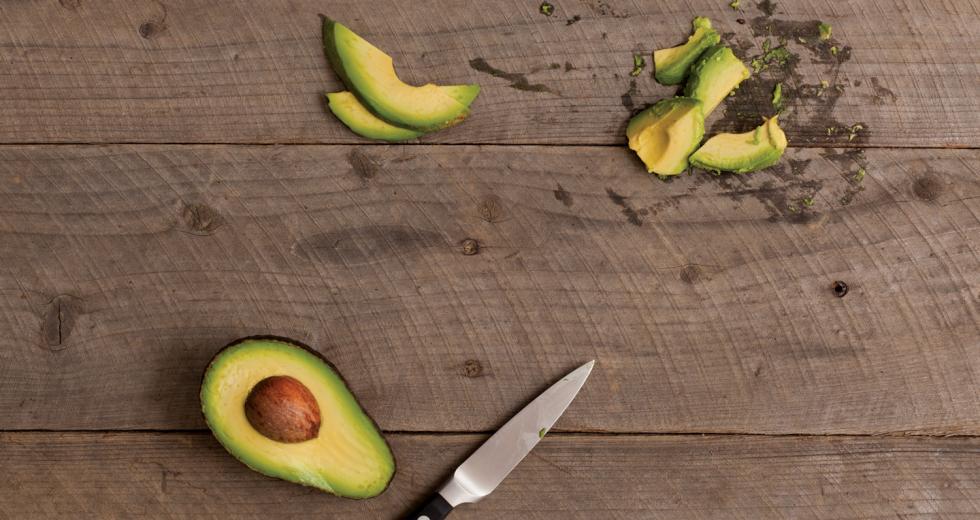Shopping carts, dinner plates and restaurant menus across the country are going green.
With avocados, that is.
A fruit long seen as an exotic treat has in recent years broken into the culinary mainstream and is now enjoying prominent placement in outlets ranging from fast food chains to cooking channels and supermarket displays.
Americans now eat more avocados in more ways than ever before; consumption of the creamy green fruit quadrupled over the last two decades, hitting a record 4.5 pounds per capita in 2011. Total consumption increased 200 percent in the past ten years alone, from about 700 million pounds in 2002 to 1.5 billion pounds in 2012.
Food industry experts say changing demographics and advances in import and distribution practices contributed to the trend. But the growth in popularity hasn’t been entirely organic. Groups representing growers and importers have poured hundreds of millions of dollars into promoting the product, launching large-scale, multi-pronged marketing campaigns.
“The avocado isn’t the first, but it is probably the most recent huge success story showing greater availability and helping consumers understand that this is a versatile food, a fun food and it’s an everyday food,” says Kathy Means, a vice president with the Produce Marketing Association. “What we’ve seen from avocados is incredibly strong marketing and really fundamental marketing.”
The avocado has been a mainstay of diets in Mexico and much of Latin America for centuries. But its reliance on public relations to win over Americans’ appetites dates back to the fruit’s earliest forays into commercial growth in the U.S.
Aguacate, one form of the Spanish name for a fruit thought to originate in Central Mexico, didn’t roll off of Americans’ tongues unfamiliar with the foreign food, according to some historical accounts. The English translation of that word — testicle — wasn’t exactly a turn-on for consumers either. “Alligator pear,” a nickname inspired by the fruit’s rough, dimpled skin, wasn’t much better.
Faced with those troubles and general disagreement over which modern version of the Aztec word to use, the American Pomological Society, U.S. Department of Agriculture and a newly formed coalition of California growers all agreed to start calling the fruit avocado. In 1915, the California Avocado Association was born.
Almost a century later, the modern effort to promote avocados extends far beyond the name. A handful of boards and commissions, mostly funded by assessments on growers and importers, spend tens of millions of dollars a year on traditional television and radio advertising, partnerships with grocery stores, restaurants and celebrity chefs and even clinical studies aimed at underscoring the food’s health benefits.
Those efforts, coupled with gains in distribution methods that allow more ripe fruit to hit the shelves, have translated into broader usage, boosting sales year round. Adam Bazarnik, director of produce and floral at Nugget Markets, says the company’s Sacramento-area stores have seen avocado sales rise substantially in the past five years or so.
“It’s become almost like an everyday item, to (the point) where there’s definitely repeat sales all the time,” he says.
California’s own avocado commission plays a central role in the effort to extend the avocado’s popularity beyond the guacamole bowl.
The commission, which was created in the 1970s, last year poured more than $11 million into a marketing campaign that included billboards, television commercials and more than 4,000 promotional grocery store displays. Web ads, social media activity and placement on grocery sale fliers further urged consumers to seek fresh, California-grown avocados. Locally, the effort includes signage and radio ads that include tags telling consumers they can pick up avocados in season at Nugget and other local markets.
While many of the ads seek to put a face to the nearly 5,000 avocado growers in California, the campaigns go beyond highlighting the origin of the avocados produced in the state.
The commission has renewed a focus on selling avocados as a breakfast food, a move analysts say could be a major boon to the industry given the habitual nature of the meal. The commission’s marketing team also sought to “claim ownership of the American summer holidays” in 2012, launching an ad campaign that turned the Fourth of July into “the strongest holiday consumption event for avocados — ever,” according to a message from Commission Chairman Ed McFadden published in the group’s latest annual report. The commission’s tracking suggests its efforts are working; more than 98 million pounds of avocados moved through the system during this year’s July 4 campaign, compared to 54.5 million pounds just two years ago.
The commission, which is overseen by the state Department of Food and Agriculture, is also relying on less conventional avenues for boosting the product’s widespread appeal.
It now engages in promotional partnerships with 25 retail food operators, including large chains like Denny’s and Chipotle. It also works with smaller, local haunts. Molly Fagnoni of Granite Bay’s Hawks Restaurant says she and her husband and business partner Mike Fagnoni now try to incorporate avocados into their menu “more thoughtfully and more frequently” since they joined the commission’s artisan chefs program. Creations include a salad built on a base of avocado mousse, and an open-faced Cajun shrimp sandwich with avocado, which the couple designed for the commission’s use.
“I definitely think guests appreciate the dishes with avocado in them, or there’s a sense that avocados are premium fruit and so when it’s added to a dish there’s a perception that there’s an added value there,” she says.
In exchange for incorporating and highlighting California avocados as part of their menus and advertising campaigns, many restaurants get cash to help with promotional efforts. That approach dates back to at least the 1990s, when the commission offered incentives to restaurants that added guacamole prepared tableside with California avocados to the menu.
“It really allowed the consumer to say, ‘Wow, that’s something I could do at home,’” says Jan DeLyser, vice president of marketing for the California Avocado Commission. “A couple of avocados, a couple of tomatoes, some onions, some garlic … that really helped make avocados just, like, ‘Oh I get it, I get how to use them.’ It was huge.”
Working with popular food bloggers and celebrity brands is also part of the strategy.
Visitors to celebrity chef and Food Network star Rachael Ray’s website, for example, will find commission-created recipes for offerings like guacamole potato salad and California avocado/mint chip whip. Other times, food bloggers or chefs contract to promote avocado recipes they develop themselves. That includes food blogger Gaby Dalkin, author of the recently released “Absolutely Avocados” cookbook. Dalkin, a culinary school graduate and avocado enthusiast who gained a large following through her “What’s Gaby Cooking” food blog, has created recipes featuring California avocados both for the commission’s website and her personal blog. She recently expanded that partnership, taping a series of YouTube videos featuring tips and ideas for cooking with the fruit.
“I think people love that they can get a certain blog and hear one specific voice and see what they have to say,” Dalkin says of the effectiveness of the partnership. “Bloggers have gotten this great credibility because of that.”
Avocado boosters from other groups agree. Emiliano Escobedo, executive director of the Hass Avocado Board, praises celebrity partnerships, as well as efforts to get the fruit on screen through placements on other cooking shows and morning show segments, as something that “helps in big ways.”
“When Rachael Ray uses avocados in the recipes, she’s basically communicating to her viewers that avocados should be in your kitchen,” he says.
Escobedo’s group, which was created by Congress in 2002 and is funded by assessments on growers and importers, does more than highlight the taste and versatility of the fruit.
It is now spending heavily on clinical studies exploring the health benefits of avocados, an effort aimed at putting a positive spin on its high calorie and fat counts. Those findings are shared with doctors, nurses and nutritionists in hopes “they will take that information, turn that around and get people to eat more avocados,” Escobedo says.
“That’s just going to unlock the next generation of growth and consumption for avocados,” says Escobedo. “What we’re going to be giving consumers is a reason to believe that they’re not only tasty and will make great dishes … but they also have some nutritional benefit that will be favorable for them.”
That strategy, taken from the playbooks of drug companies that have long used science to back their products, is especially helpful in increasing appeal among more educated consumers, says Michael Cohen, a fellow at New York University’s Leonard N. School of Business Center for Measurable Marketing.
“In terms of food companies, now that people understand the importance of nutrition, it does create a useful avenue for PR,” he says.
The latest marketing blitz started after an 80-year ban on imported avocados was lifted in the early 2000s. Growers and importers have made significant investments in technology and infrastructure to ensure avocados arrive on the shelves ripe and ready to eat. Demographic shifts, particularly the growth in the Hispanic population, have also fueled demand for avocados in stores and restaurants.
That spike in supply, however, has also increased the competition for an item that can come at a high cost compared to many items in the produce section.
In addition to the California Avocado Commission, growers and importers from places like Mexico, Chile and Peru run their own well-funded promotional efforts, complete with advertising campaigns and celebrity endorsements. Florida avocados, which are a slightly different variety than Hass avocados grown in the other regions, are also backed by separate efforts.
Despite the gains in popularity, all are competing for what remains a relatively small sliver of the market. Research by the marketing firm NPD Group shows that while the percentage of consumers purchasing avocados in a two-week window has tripled in the past decade, just 6 percent of consumers surveyed by the firm fall into that regular avocado buyer category.
It’s been a movement upward. There’d be no question about it … (But) we have a long way to go before this becomes onions or tomatoes,” says Harry Balzer, a chief analyst with the group and the author of an annual report called “Eating Patterns in America.”
Avocado advocates say they don’t want the fruit to be seen as an onion or tomato, but a premium product worthy of a higher price tag. Still, they say, those numbers reinforce the common goal of the sometimes-rival efforts to promote the product.
“At the end of the day,” Escobedo says, “I think when the consumer walks in the stores, what we all want is to make sure the avocado gets put in the basket.”
Avocado Raspberry Smoothie
1 cup water or almond milk
juice from 1/2 lemon
1/2 California avocado
1-2 cups spinach
1/2 cup frozen pineapple
1 1/2 cup frozen raspberries
1 cup ice
Blend all fresh ingredients. Add frozen fruit and ice and blend again.
Recommended For You

Striking Oil
In Woodland, La Tourangelle cracks the nut oil market
Pulling up to the bland business park that is home to La Tourangelle’s nut oil bottling facility gives no indication of the nexus of culinary artistry housed inside.
But step through the doors and start talking to Matthieu Kohlmeyer, the energetic founder and CEO of the Woodland company, and you’ll discover that this quiet farming town is home to a vibrant French connection and a business that’s ridden the wave of consumer health trends and successfully plugged into the farm-to-fork movement.

Tough Nut to Crack
Almonds bust then boom in China
Richard Waycott says there are no silver bullets in the remarkable double-digit growth of California almond exports to China but rather a carefully honed strategy built on introducing almonds to a “pre-existing snacking culture.”



